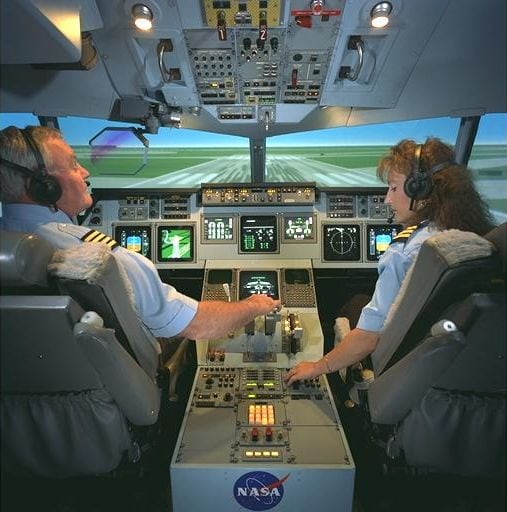 |
| Cockpit of a twinjet flight simulator. Photo: Wikimedia |
[Avionics Today 04-15-2016] The FAA has announced two new agency rules dealing with flight simulators and aviation training devices that the agency hopes will improve airline pilots’ response to a number of unusual situations they may encounter, and give pilots more credit toward the requirements for an instrument rating. The FAA says the rule, published on March 30, sets new standards for flight simulator evaluation and qualification and the new standards are designed to make simulator training and testing more accurate and realistic in scenarios involving stalls, upset recognition and recovery techniques, maneuvers in icing conditions, takeoffs and landings in gusting crosswinds, and bounced landing recovery. The FAA required training for most of these maneuvers in a rule published on November 12, 2013.
The new rule also addresses a possible lack of simulator fidelity identified in several National Transportation Safety Board (NTSB) safety recommendations and provides greater harmonization with international guidance for flight simulator training. The FAA anticipates companies will begin modifying simulators as soon as data packages are available. The agency estimated one-third of simulators to be used for the new training will be modified in each of the next three years. Air carriers must develop training programs using simulators that meet the upgraded requirements by March 12, 2019.
In a final rule published on April 11, the agency increases the Aviation Training Device (ATD) hours pilots can credit toward an instrument rating. The FAA now allows up to 10 hours credit in a basic aviation-training device and up to 20 hours in an advanced aviation-training device, not to exceed a maximum of 20 total hours under part 61. The previous maximum allowance was 10 hours in an FAA-approved aviation-training device.
A basic aviation-training device is not required to have a visual system, GPS moving map, autopilot or independent instructor control station. An advanced aviation-training device must have these additional features, and a few other aircraft-specific functions. Basic aviation training devices may only be used for training specific to the private pilot certificate instrument rating requirements. Advanced aviation training devices can be used to satisfy training for higher-level certification such as flight instructor, commercial pilot and airline transport pilot.
The FAA also is changing 141 pilot school regulations to allow more ATD credit toward the 35 hours training needed for an instrument rating. Pilot School graduates may now apply up to 8.75 hours credit for training in a basic aviation-training device and up to 14 hours in an advanced aviation-training device, subject to a 14-hour total credit. The previous rule limited credit in any ATD to 3.5 hours for the instrument rating.